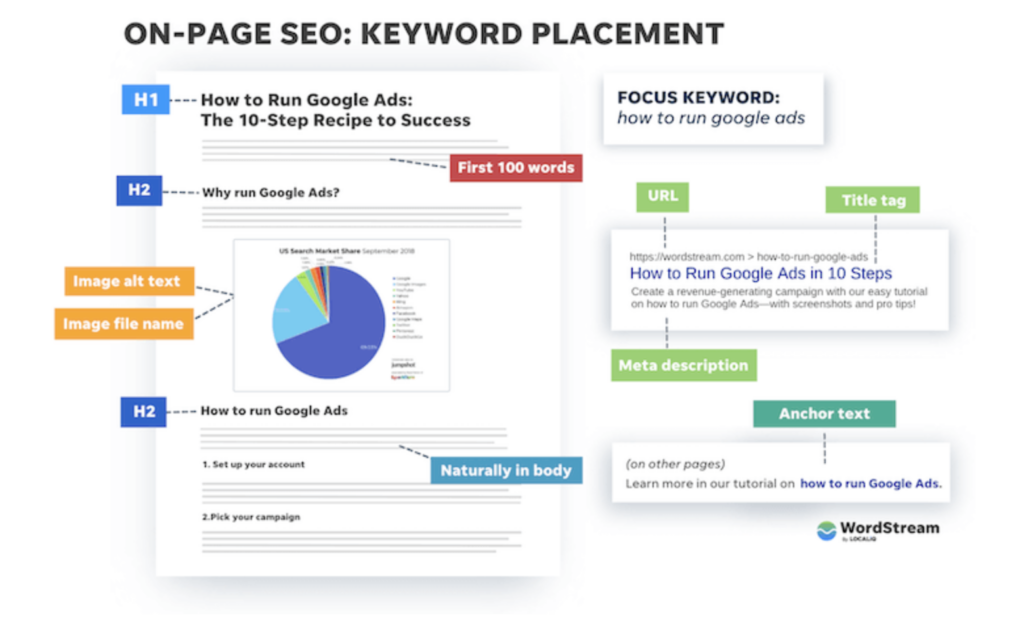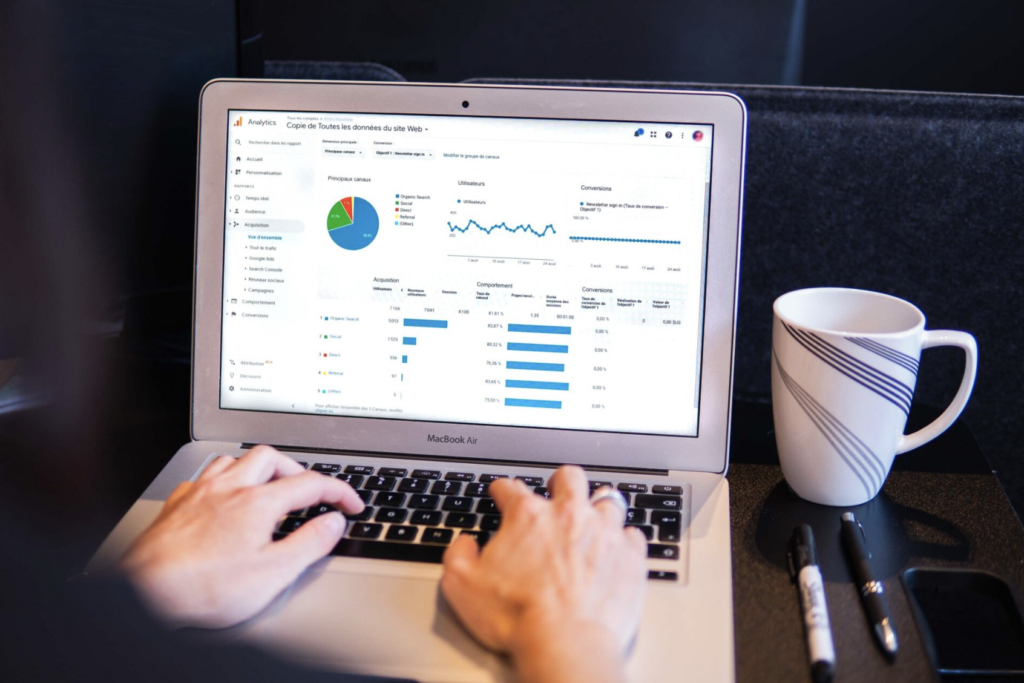Do you want to increase the visibility of your website, get more organic visitors, and improve user experience? To reach online success, it’s essential for one to be knowledgeable of on-page SEO.
A vital element in any digital marketing plan.
As search engine algorithms are constantly changing and escalating competition, keeping up-to-date with current strategies regarding on-page SEO is critical. We’ll dive into effectively utilizing these techniques so that you can outrun competitors and take control of the search results. Let us start.
Key Takeaways
- Optimize content, metadata, and site architecture for users and search engines.
- Utilize keyword research tools to select relevant keywords.
- Monitor & measure performance regularly to maximize SEO efforts.
Table of Contents
Understanding On-Page SEO

When it comes to optimizing web page content for search engines and users, the practice is called On-page SEO. This makes a website more visible in SERPs by utilizing title tags, internal and external links, target keywords among other elements which are different from those used in off-page SEO (which focuses on external factors like backlinks or social signals).
The main aim of this optimization process is to focus mainly on the actual page’s content and related metadata that crawlers look out for when understanding web pages.
To succeed with your online presence you should get acquainted with basics of SEO as they can help you increase organic impressions significantly.
Thanks to updated algorithms such as Hummingbird RankBrain BERT MUM etc. specially designed by Google.
Allows them to better interpret user search intent while increasing relevance towards items sought after. Doing comprehensive work during each blog post release helps position websites favorably. Thus appearing higher up within Search engine results ranking algorithm.
It also brings value if sources present link quality using credible sites outside domain site being evaluated. Targeting specific audience interested in similar products or services.
While links and metadata are important, so is the content that is produced on the page. Having well written and thought our content that resonates with your audience helps with the time spent on the page. When a reader spends more time on the page it shows Google that the content is important. The importance of your content is also taken into consideration with search engine algorithms.
Key Components of On-Page SEO

On-page SEO involves various factors that are seen by users. Such as keyword research, page content, website structure, user experience, and the technical side of SEO.
Let us investigate each of these vital components in more detail to have a clear picture on how they can contribute to an effective strategy with regards to optimization.
Creating High-Quality Content
High quality content is integral to having a successful on page SEO strategy.
To ensure that your chosen keywords and topics are applicable, research related subject matter, analyze competitors’ tactics, and using keyword research tools can be helpful to find the most effective avenues for optimization.
It’s important to add alt text with images when optimizing pages.
Make sure that the image file size is minimal as well as selecting descriptive filenames. In doing so will help make your content and images more accessible to search engines.
When crafting content, take into account customer journeys along with what site visitors’ intended searches might be. So the material you create captivates readership and meets their needs appropriately. Enhancing readability by adding subheadings plus bullets or pictures makes it easier for site users to consume info quickly while still keeping all vital information intact.
Optimizing Metadata for Search Engines
Optimizing metadata is a factor in helping Google grasp and appear website material correctly in search engine listings. It can have an enormous influence on the ranking potential of any page title or given site. While simultaneously providing another signal to web crawlers about what that page’s title contains.
When optimizing this data,
- Title tags: Descriptive text that appear in search engine results pages (SERPs) and on browser tabs.
- Meta descriptions: Descriptive texts that appear below the title tag in search engine results pages (SERPs).
- Image alt text: Descriptive text that is used to describe an image to people who cannot see it.
All should be concentrated on so as to provide extra evidence for search engines with regards to your content’s subject matter. Incorporating keywords you are trying to target for into anchor text for these elements will greatly benefit your efforts put towards on-page SEO strategies.
In order to maximize results from said optimization procedure. Practicing best methods such as bolstering chances of chosen meta description being the same keyword used by Google. Along with examining if duplicate meta descriptions exist must both be carried out diligently and help significantly when it comes to improvements.
Keyword Research and Optimization
Keyword research and keyword density is an essential part of of optimization that links your business to the desired demographic with appropriate keywords. When selecting keyword targets, it’s important to think about realistic keyword difficulty levels. Higher cost-per-click (CPC) values and meaningful search volume. Utilizing relevant words in your SEO helps search engines understand the content of indexed pages on your website so they can rate them accurately.
To efficiently optimize these terms, make sure not to cram them into articles or into other websites, too much. A few tips and couple mentions throughout are enough for Google crawling algorithms’ needs while avoiding keyword stuffing as this could negatively impact rankings.
Site Architecture and Page URL Structure
Optimizing the architecture of a website, including SEO friendly URLs with its key phrases. Ensuring that search engines can both crawl and index it.
Shortened descriptors are better for organizational purposes. Pages within the site hierarchy are created from blog posts or other internal content types.
The process of connecting webpages on your own website or domain through hyperlinks helps distribute page rank throughout relevant categories/service-related pages via link equity. Meanwhile, rich snippets resulting from structured data added to these same websites help search engine algorithms interpret them more effectively too.
To maximize optimization potential on mobile devices, focus on accessibility measures like utilizing Google’s mobile test regulations before implementing a CDN (Content Delivery Network), which will ultimately lower page loading speeds – something else known to have an effect on rankings according to Google’s standards.
Enhancing User Experience (UX)

Quality content is necessary that focuses around satisfying the search intent of users. Various tactics can be utilized in order to make your written SEO material as valuable as possible. Like improving UX signals which helps keep people searching Google stay longer and increases your page rankings.
Google states they gather anonymous interaction information so they have a better understanding if results are connected with queries. It’s vital you optimize your article for providing value, appeal to readership, and stimulate them to interact with it.
With your site. This will not only contribute positively towards optimizing on-page SEO, but also enhance the overall experience visitors get when visiting websites.
Advanced On-Page SEO Techniques

Taking your SEO to the next level necessitates employing more advanced techniques that surpass just the basics. These strategies can be used to maximize metadata, content quality and user experience, which in turn leads to higher rankings for search engines plus increased organic traffic on your website.
To aid Google properly understanding and present site material correctly inside its results pages. Optimizing metadata is vitally important.
By following leading practices like including a year with the title tag of time-sensitive topics, formulating title tags emphasizing questions rather than facts, evading identical meta descriptions, duplicate title tags etc., you will quickly realize visible enhancements from small data optimization efforts performed by yourself or others.
When it comes down to content though – investing energy into creating meaningful information meeting customer needs should take precedence over any attempts at keyword stuffing and/or duplicating existing articles, all while attempting to enhance page SEO too.
On top of this cycle are tools like Search Console & Google Analytics – utilized for measuring one’s success and ongoing work since they enable tracking keyword standings against rivaling competitors’.
Analyzing visitor patterns during their visits plus other necessary details useful in evaluating progress generated.
Monitoring and Measuring On-Page Success

Keyword research is an important task for any business. By tracking keyword rankings and topics per page, optimizing your content with one dedicated keyword increases the chances of it ranking higher on search engine result pages.
To measure effectiveness in terms of optimization techniques and to track how visitors find you through these channels, Google Analytics and Search Console are essential tools to keep tabs on performance changes over time as well as any errors that need addressing.
As another crucial step in ensuring successful SEO strategies remain effective. Be sure all pertinent URLs have been indexed by running a Site Audit Tool regularly or investigate if they’ve been excluded from indexing so visibility remains optimum within SERPs.
Common On-Page SEO Mistakes to Avoid

Remain aware and stay away from common mistakes. Some recurring errors that are made in this area include keyword stuffing, duplicate content creation, inadequate meta tags optimization, slow website loading speed, targeting wrong keywords or incorrectly addressing search intent. Default metadata not properly edited out, etc.
No good structure for contents also results in weak or duplicated material as well as poorly tailored title tags being used – all leading cause issues which can detrimentally affect a webpage’s visibility within search engine rankings.
By recognizing such problems early enough and taking proper measures towards rectifying them promptly you should be able to enhance your page and on site SEO endeavors effortlessly while at the same time keeping yourself ahead of rivals when competing over getting listed high among SERPs.
Wrapping Up
On-page SEO is an essential component to success online and growing organic traffic. Becoming familiar with the principles of page optimization such as refining your site structure, editing metadata, creating well crafted content along with proper keyword research will increase your site speed visibility in search engine results pages and draw more visitors.
Being mindful when monitoring progress regarding SEO efforts also helps in avoiding common mistakes. Taking action by committing yourself and putting the correct strategies into place are required to emerge high among search results rankings while obtaining web based triumphs over the coming year.
Frequently Asked Questions
What is an example of SEO on-page?
On-page SEO is a great way to boost website visibility and increase traffic, making use of elements like headings/subheadings, internal links and optimizing images with alt text.
All these things help search engines put your site at the top when users are looking for something specific. Implementing this technique properly will bring you tangible results in terms of better rankings in SERP (Search Engine Results Pages) as well as improved web presence altogether.
What is on-page SEO vs SEO?
On page SEO is about strategies implemented directly on a website, like using appropriate key phrases in headlines and titles. In contrast, off page SEO involves activities occurring outside the site such as constructing and link building backlinks or taking part in social media campaigns to acquire press coverage.
How do you do SEO on a page?
To increase the SEO of a webpage, you must examine keywords and apply appropriate terms throughout.
Includes headings, images descriptions, URLs and the initial 100 words on the page. Be sure your material is succinct yet effective with no overloading of phrases for optimization purposes.
Optimize the page speed and loading time by making it responsive to all devices like phones or tablets etc.
